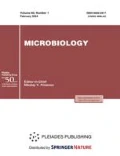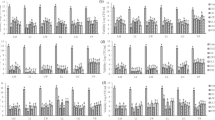Abstract
The majority of components of the essential oil from Cinnamomum cassia bark were identified by gas chromatography and mass spectrometry (GC-MS) in this study. The trans-cinnamaldehyde (68.52%) was found to be the major compound. The antibacterial activity of essential oil against four food-related bacteria was evaluated. The results showed it was stronger effect against Staphylococcus aureus with both the largest ZOI of 27.4 mm and the lowest minimum inhibitory concentration (MIC) of 2.5 mg/mL and minimum bactericidal concentration (MBC) of 5.0 mg/mL respectively. Postcontact effect (PCE) assay also confirmed the essential oil had a significant effect on the growth rate of surviving S. aureus and Escherichia coli. The mechanism against S. aureus and E. coli may be due to the increase in permeability of cell membranes, and the leakage of intracellular constituents based on cell permeability assay and electron microscopy observations.
Similar content being viewed by others
References
Sokmen, A., Gulluce, M., Akpulat, H.A., Daferera, D., Tepe, B., and Polissiou, M., The in vitro antimicrobial and antioxidant activities of the essential oils and methanol extracts of endemic Thymus spathulifolius, Food Control, 2004, vol. 15, no. 8, pp. 627–634.
Wu, V.C.H., Qiu, X., de los Reyes, B.G., Lin, C.-S., and Pan, Y., Application of cranberry concentrate (Vaccinium macrocarpon) to control Escherichia coli O157:H7 in ground beef and its antimicrobial mechanism related to the downregulated slp, hdeA and cfa, Food Microbiol., 2009, vol. 26, no. 1, pp. 32–38.
Shan, B., Cai, Y.-Z., Brooks, J. D., and Corke, H., Antibacterial properties and major bioactive components of cinnamon stick (Cinnamomum burmannii): activity against foodborne pathogenic bacteria, J. Agric. Food Chem., 2007, vol. 55, no. 14, pp. 5484–5490.
Burt, S., Essential oils: their antibacterial properties and potential applications in foods—a review, Int. J. Food Microbiol., 2004, vol. 94, no.3, pp. 223–253.
Bakkali, F., Averbeck, S., and Averbeck, D., Biological effects of essential oils—a review, Food Chem. Toxicol., 2008, vol. 46, no. 2, pp. 446–475.
Lanciotti, R., Gianotti, A., Patrignani, F., Belleti, N., Guerzoni, M.E., and Gradini, F., Use of natural aroma compounds to improve shelf life and safety of minimally processed fruits, Trends Food Sci.Technol., 2004, vol. 15, nos. 3–4, pp. 201–208.
Taarit, M.B., Msaada, K., Hosni, K., Chahed, T., and Marzouk, B., Essential oil composition of Salvia ver- benaca L. growing wild in Tunisia, J. Food Biochem., 2010, vol. 34, no. 1, pp. 142–151.
Sagdic, O., Karahan, A.G., Ozcan, M., and Ozkan, G., Effect of some spice extracts on bacterial inhibition, Food Sci. Technol. Int., 2003, vol. 9, no. 5, pp. 353–358.
Salgueiro, L., Martins, A.P., and Correia, H., Raw materials: the importance of quality and safety, a review, Flavour Frag. J., 2010, vol. 25, no. 5, pp. 253–271.
Choi, J., Lee, K.-T., Ka, H., Jung, W.-T., Jung, H.-J., and Park, H.-J., Constituents of the essential oil of the Cinnamomum cassia stem bark and the biological properties, Arch. Pharm. Res., 2001, vol. 24, no.5, pp. 418–423.
Wang, L., Wang, Z.-M., Li, T.-C., Zhou, X., Ding, L., and Zhang, H.-Q., Rapid extraction and analysis of essential oil from Cinnamomum cassia Presl, Chem. Res. Chinese Univ., 2008, vol. 24, no. 3, pp. 275–280.
Yu, T., Lee S., Yang, W.S., Jang, H.-J., Lee, Y.J., and Kim, T.W., The ability of an ethanol extract of Cinnamomum cassia to inhibit Src and spleen tyrosine kinase activity contributes to its anti-inflammatory action, J. Ethnopharmacol., 2012, vol. 139, no. 2, pp. 566–573.
Geng, S., Cui, Z., Huang, X., Chen, Y., Xu, D., and Xiong P., Variations in essential oil yield and composition during Cinnamomum cassia bark growth, Ind. Crops Products, 2011, vol. 33, no. 1, pp. 248–252.
Lin, C.-C., Wu, S.-J., Chang, C.-H., and Ng, L.-T., Antioxidant activity of Cinnamomum cassia, Phytother. Res., 2003, vol. 17, no. 7, pp. 726–730.
Giordani, R., Regli, P., Kaloustian, J., and Portugal, H., Potentiation of antifungal activity of amphotericin B by essential oil from Cinnamomum cassia, Phytother. Res., 2006, vol. 20, no. 1, pp. 58–61.
Ooi, L.S.M., Li, Y.L., Kam, S.L., Wang, H., Wong, E.Y. L., and Ooi, V.E.C., Antimicrobial activities of cinnamon oil and cinnamaldehyde from the Chinese medicinal herb Cinnamomum cassia Blume, Amer. J. Chin. Med., 2006, vol. 34, no. 3, pp. 511–522.
Lee, S.-H., Chang, K.-S., Su, M.-S., Huang, Y.-S., and Jang, H.-D., Effects of some Chinese medicinal plant extracts on five different fungi, Food Control, 2007, vol. 18, no. 12, pp. 1547–1554.
Chaudhry, N.M.A., and Tariq, P., Anti-microbial activity of Cinnamomum cassia against diverse microbial flora with its nutritional and medicinal impacts, Pakistan J. Bot., 2006, vol. 38, no. 1, pp. 169–174.
Oussalah, M., Caillet, S., Saucier, L., and Lacroix M., Inhibitory effects of selected plant essential oils on the growth of four pathogenic bacteria: E. coli O157:H7, Salmonella typhimurium, Staphylococcus aureus and Listeria monocytogenes, Food Control, 2007, vol. 18, no. 5, pp. 414–420.
Unlu, M., Ergene, E., Unlu, G.V., Zeytinoglu, H.S., and Vural, N., Composition, antimicrobial activity and in vitro cytotoxicity of essential oil from Cinnamomum zeylanicum Blume (Lauraceae), Food Chem. Toxicol., 2010, vol. 48, no. 11, pp. 3274–3280.
Park, I.-K., Lee, H.-S., Lee, S.-G., Park, J.-D., and Ahn, Y.-J., Insecticidal and fumigant activities of Cinnamomum cassia bark-derived materials against Mechoris ursulus (Coleoptera: Attelabidae), J. Agric. Food Chem., 2000, vol. 48, no. 6, pp. 2528–2531.
Chang, K.-S., Tak, J.-H., Kim, S.-I., Lee, W.-.J., and Ahn, Y.-J., Repellency of Cinnamomum cassia bark compounds and cream containing cassia oil to Aedes aegypti (Diptera: Culicidae) under laboratory and indoor conditions, Pest Manag. Sci., 2006, vol. 62, no. 11, pp. 1032–1038.
Ng, L.-T., and Wu, S.-J., Antiproliferative activity of Cinnamomum cassia constituents and effects of Pifithrin-alpha on their apoptotic signaling pathways in HepG2 cells, Evid.-Based Complement. Altern., 2009, vol. 2011, pp. 1–6.
Koppikar, S.J., Choudhar, A.S., Suryavanshi, S.A., Kumari, S., Chattopadhyay, S., and Kaul-Ghaneka, R., Aqueous cinnamon extract (ACE-c) from the bark of Cinnamomum cassia causes apoptosis in human cervical cancer cellline (SiHa) through loss of mitochondrial membrane potential, BMC Cancer, 2010, vol. 10, pp. 1–12.
Viuda-Martos, M., Mohamady, M.A., Fernández-López, J., Abd ElRazik, K.A., Omer, E.A., and Pérez-Alvarez, J.A., In vitro antioxidant and antibacterial activities of essentials oils obtained from Egyptian aromatic plants, Food Control, 2011, vol. 22, no. 11, pp. 1715–1722.
Kubo, I., Fujita, K., Kubo, A., Nihei, K., and Ogura, T., Antibacterial activity of coriander volatile compounds against Salmonella choleraesuis, J. Agric. Food Chem., 2004, vol. 52, no. 11, pp. 3329–3332.
Daglia, M., Papetti, A., Grisoli, P., Aceti, C., Dacarro, C., and Gazzani, G., Antibacterial activity of red and white wine against oral streptococci, J. Agric. Food Chem., 2007, vol. 55, no. 13, pp. 5038–5042.
Kong, M., Chen, X.G., Liu, C.S., Liu, C.G., Meng, X.H., and Yu, L.J., Antibacterial mechanism of chitosan microspheres in a solid dispersing system against E. coli, Colloids Surfaces B: Biointerfaces, 2008, vol. 65, no. 2, pp. 197–202.
Gao, C., Tian, C., Lu, Y., Xu, J., Luo, J., and Guo, X., Essential oil composition and antimicrobial activity of Sphallerocarpus gracilis seeds against selected food-related bacteria, Food Control, 2011, vol. 22, nos. 3–4, pp. 517–522.
Figueiredo, A.C., Barroso, J.G., Pedro, L.G., and Scheffer, J.J.C., Factors affecting secondary metabolite production in plants: volatile components and essential oils, Flavour Frag. J., 2008, vol. 23, no. 4, pp. 213–226.
Tao, L., Huang, J., and Mai H., A comparison of the constituents of essential oils from Cinnamomum cassia Presl. extracted by supercritical fluid extraction and steam distillation, J. Instr. Analysis, 2004, vol. 23, no. 4, pp. 65–67 (In Chinese with English abstract).
Qin, Y.-R., Zhu, J.-Y., Zhang, Z.-Y., Zhang, M., and Qin, M.-H., Annual variation laws of main chemical compositions and oil yielding rate in branches and leaves of Cinnamomum cassia, Nonwood Forest Res., 2006, vol. 24, no. 2, pp. 9–13 (In Chinese with English abstract).
Lin, J., Xu, L.-Z., Lin, J.-Y., and Zou, Z.-M., Study on contents of cinnamaldehyde and cinnamic acid and distribution of Ramulus cinnamomi, Chin. Pharm. J., 2005, vol. 40, no. 23, pp. 1784–1787 (In Chinese with English abstract).
Woehrlin, F., Fry, H., Abraham, K., and Preiss-Weigert, A., Quantification of flavoring constituents in cinnamon: high variation of coumarin in cassia bark from the German retail market and in authentic samples from Indonesia, J. Agric. Food Chem., 2010, vol. 58, no. 19, pp. 10568–10575.
Gill, A.O., and Holley, R.A., Disruption of Escherichia coli, Listeria monocytogenes and Lactobacillus sakei cellular membranes by plant oil aromatics, J. Agric. Food Chem., 2006, vol. 108, no. 1, pp. 1–9.
Lv, F., Liang, H., Yuan, Q., and Li, C., In vitro antimicrobial effects and mechanism of action of selected plant essential oil combinations against four food-related microorganisms, Food Res. Int., 2011, vol. 44, no. 9, pp. 3057–3064.
Bajpai, V.K., Sharma, A., Baek, and K.-H., Antibacterial mode of action of Cudrania tricuspidata fruit essential oil, affecting membrane permeability and surface characteristics of food-borne pathogens, Food Control, 2013, vol. 32, no. 2, pp. 582–590.
Rhayour, K., Bouchikhi, T., Elaraki, T.A., Sendide, K., and Remmal, A., The mechanism of bactericidal action of oregano and clove essential oil and of their phenolic major components on Escherichia coli and Bacillus subtilis, J. Essent. Oil Res., 2003, vol. 15, no. 4, pp. 286–292.
Cox, S.D., Mann, C.M., Markhan, J.L., Gustafson, J.E., Warmington, J.R., and Wyllie, S.G., Determining the antimicrobial action of tea tree oil, Molecules, 2001, vol. 6, no. 2, pp. 87–91.
Author information
Authors and Affiliations
Corresponding author
Additional information
The article is published in the original.
Rights and permissions
About this article
Cite this article
Huang, D.F., Xu, J.G., Liu, J.X. et al. Chemical constituents, antibacterial activity and mechanism of action of the essential oil from Cinnamomum cassia bark against four food-related bacteria. Microbiology 83, 357–365 (2014). https://doi.org/10.1134/S0026261714040067
Received:
Published:
Issue Date:
DOI: https://doi.org/10.1134/S0026261714040067



